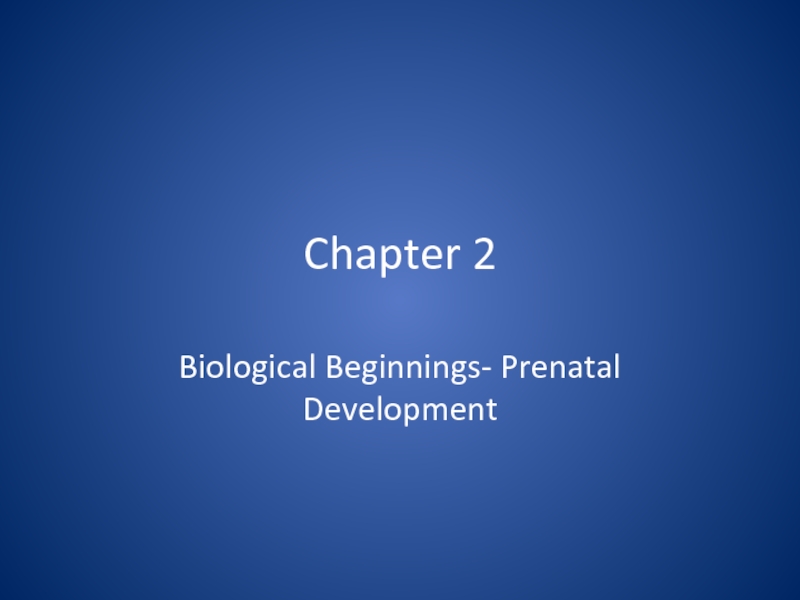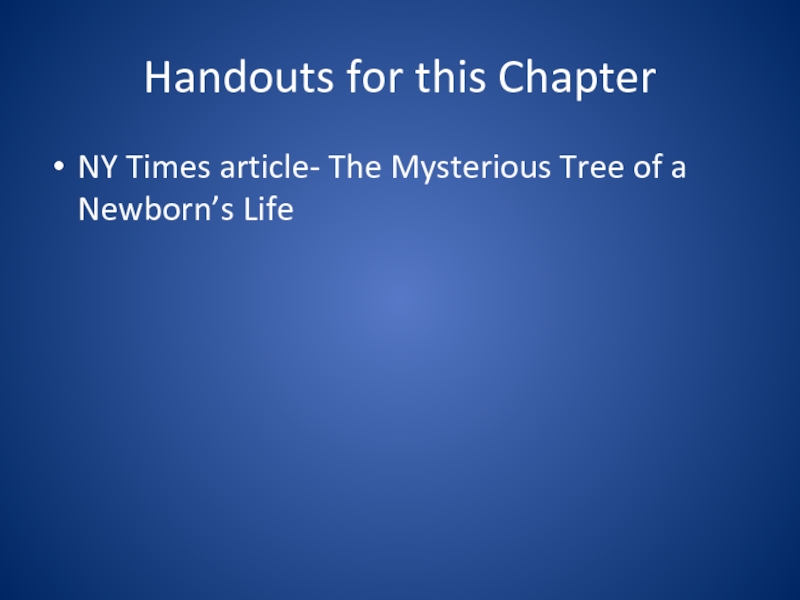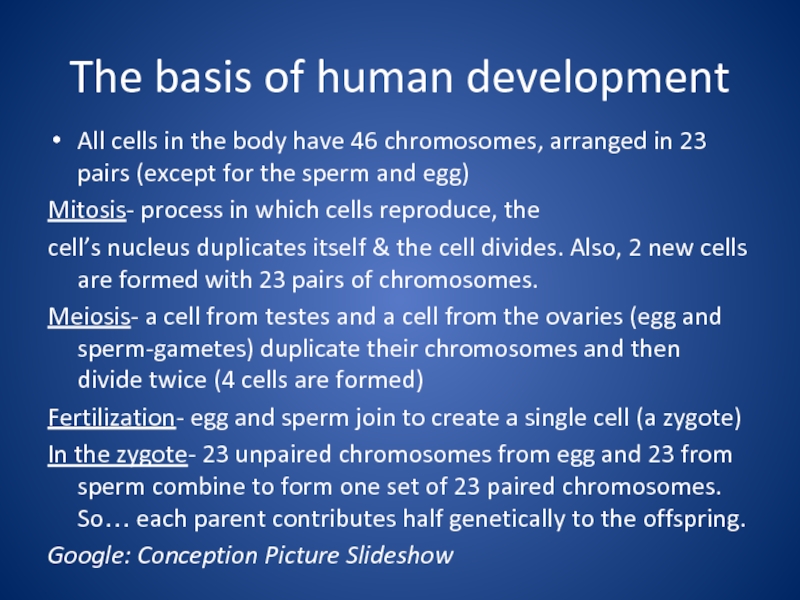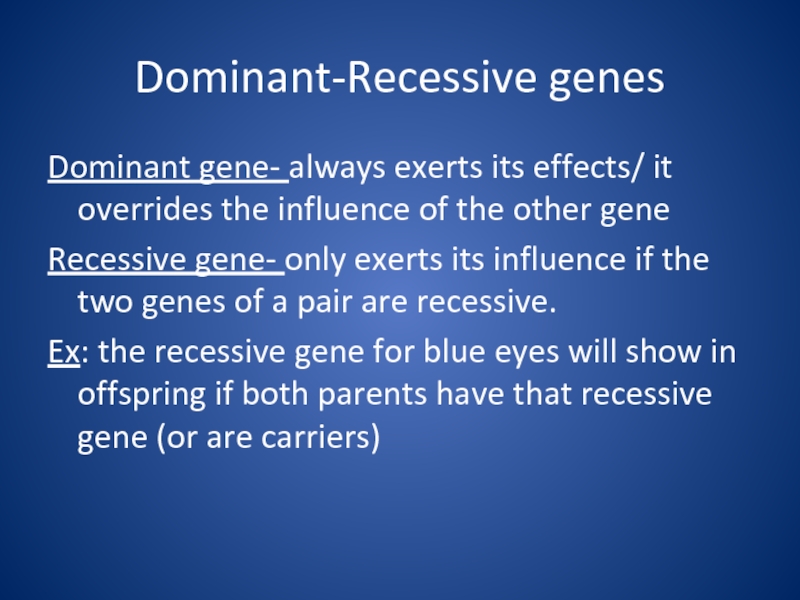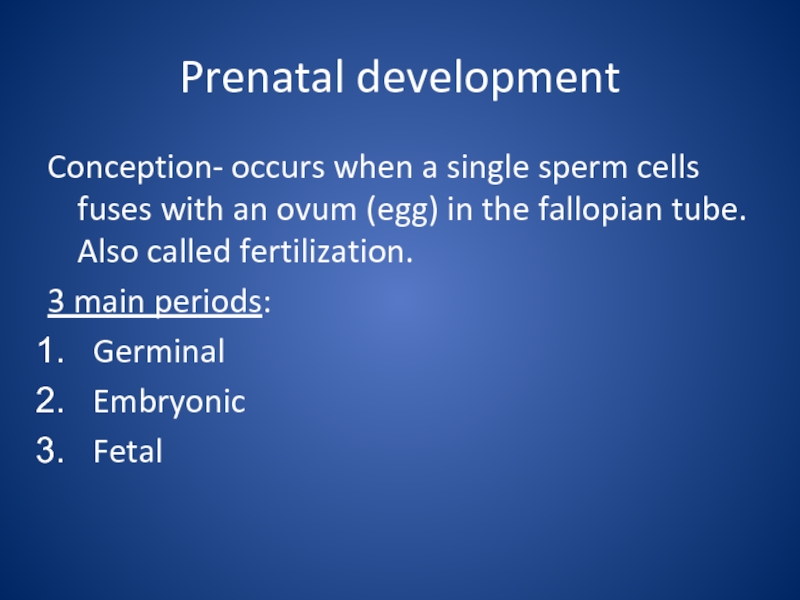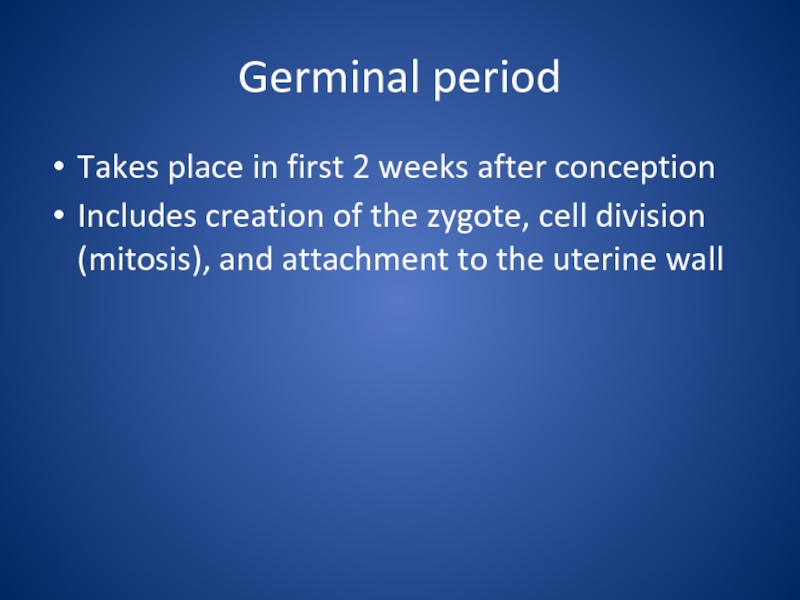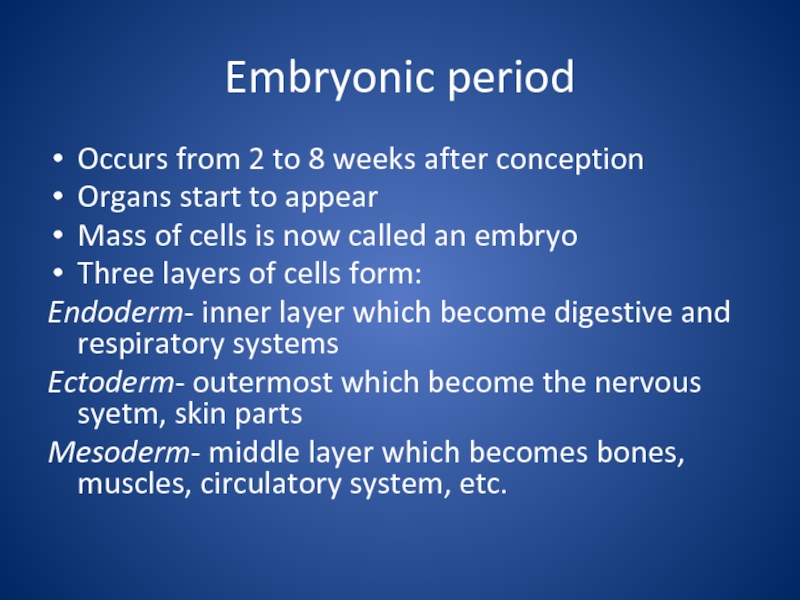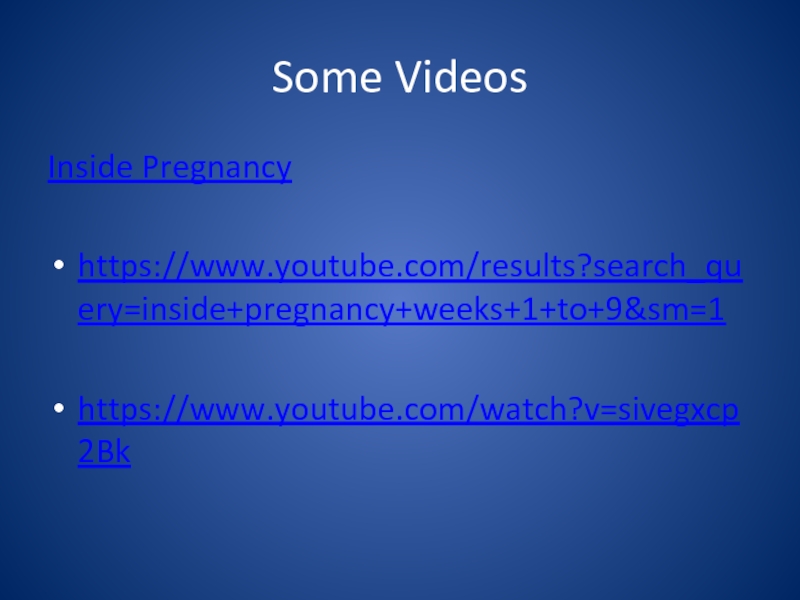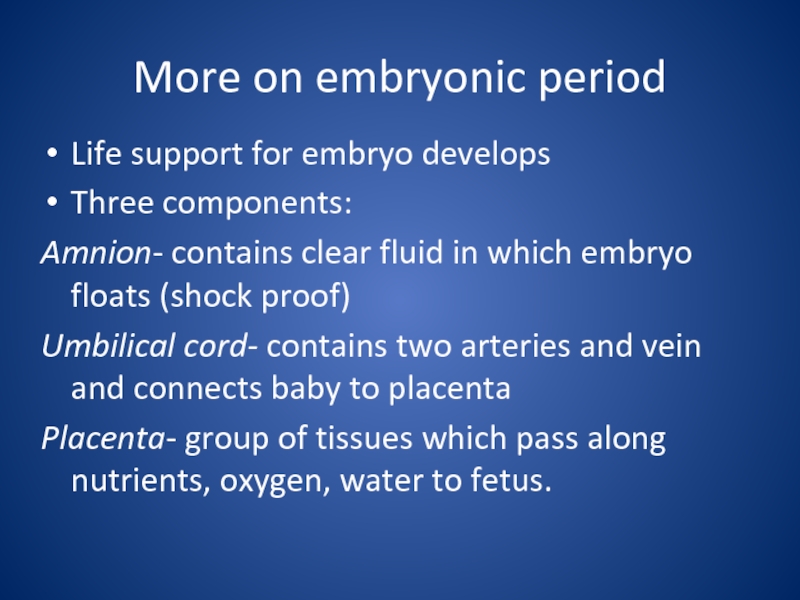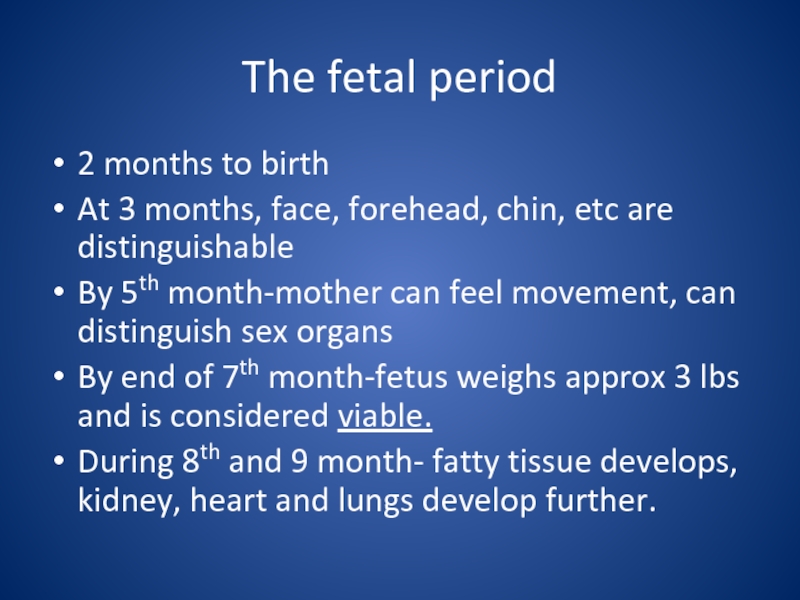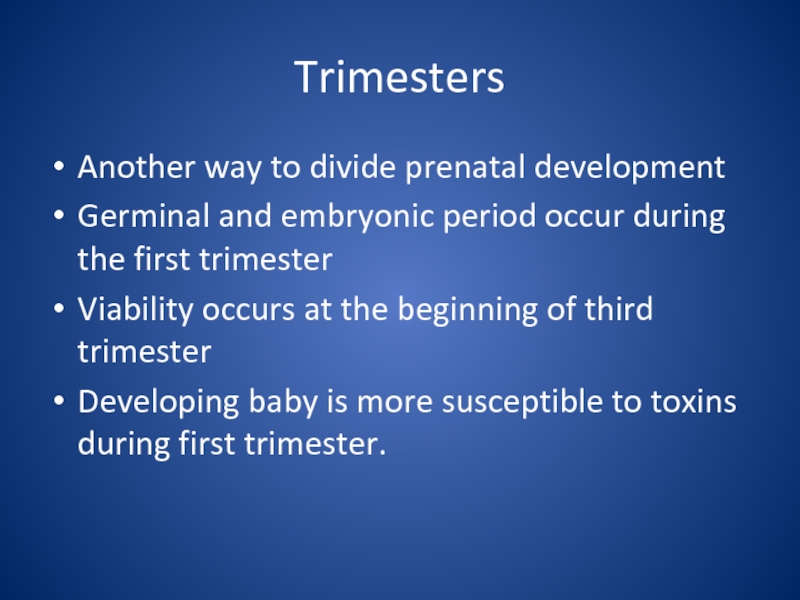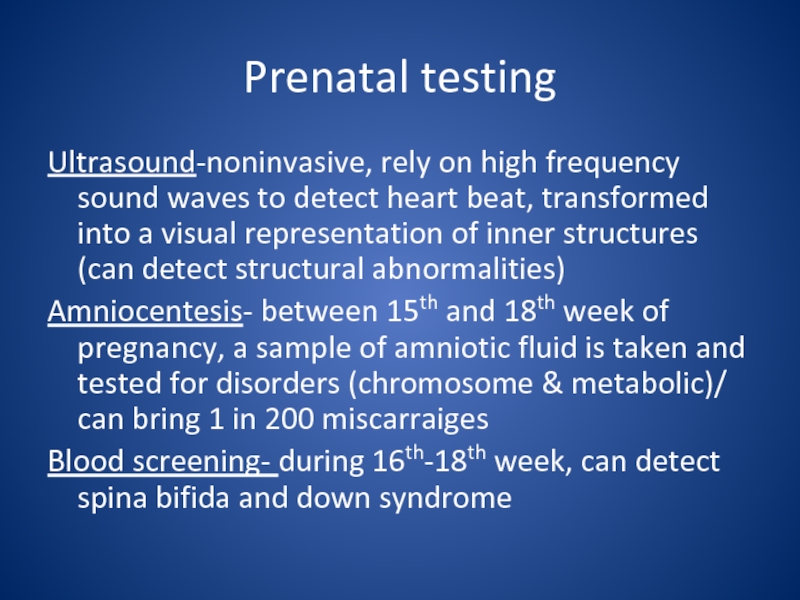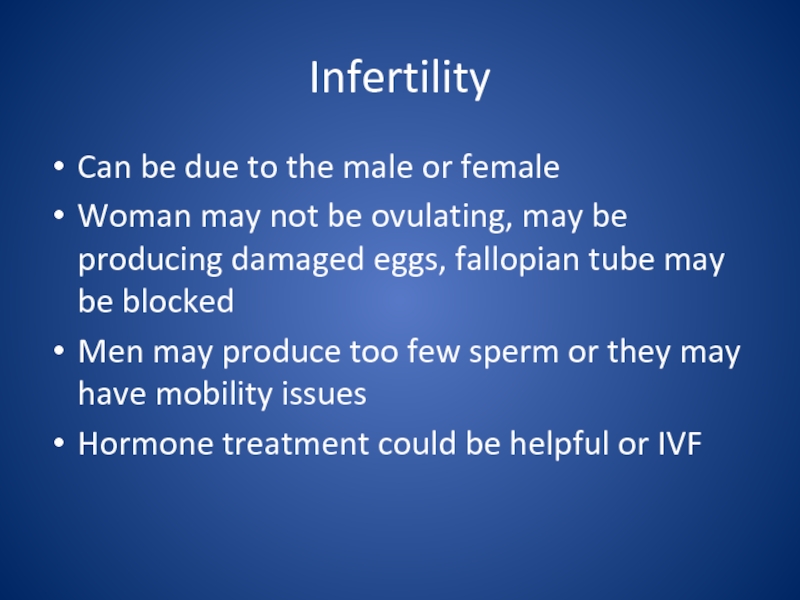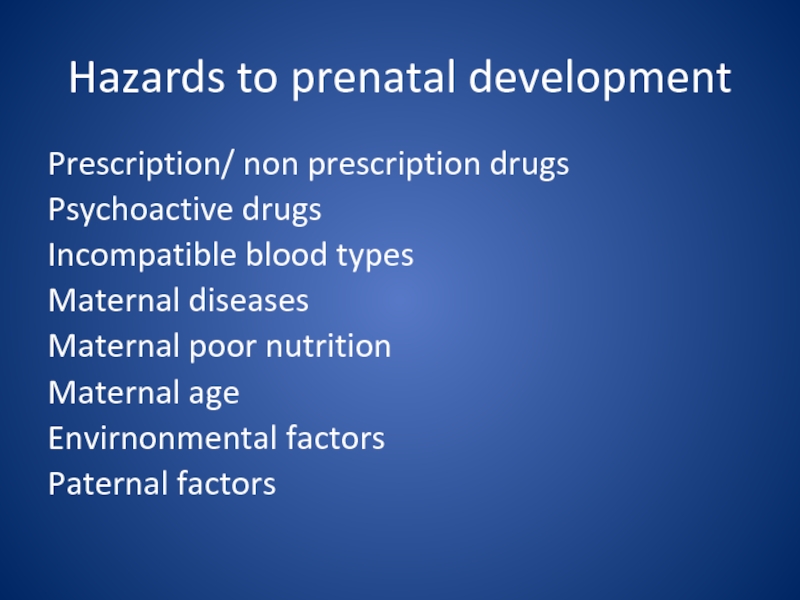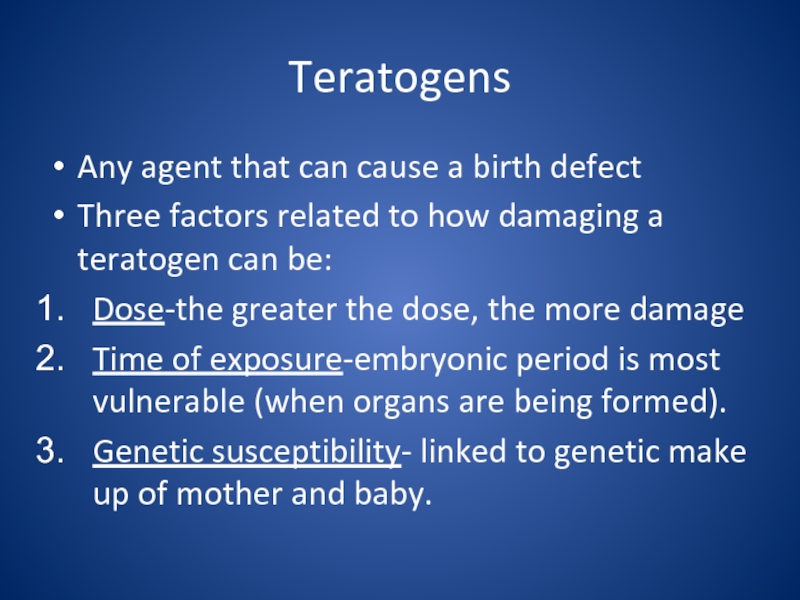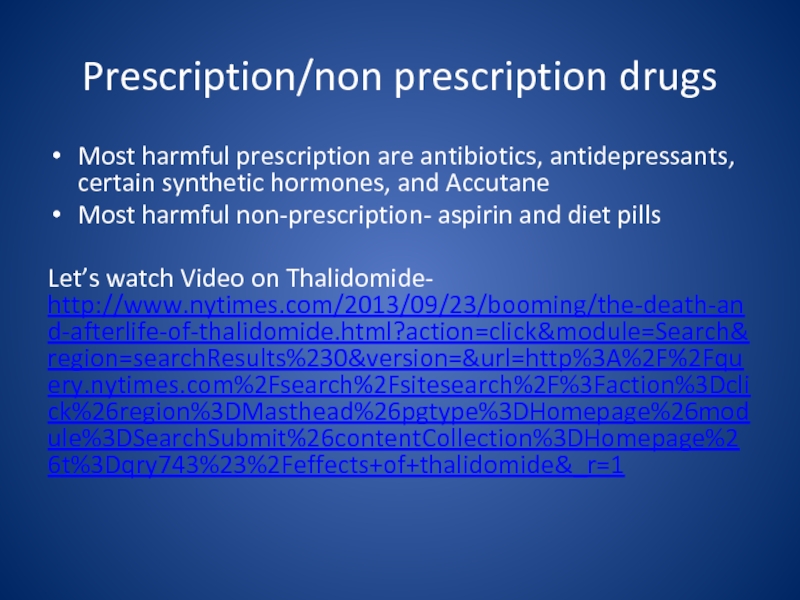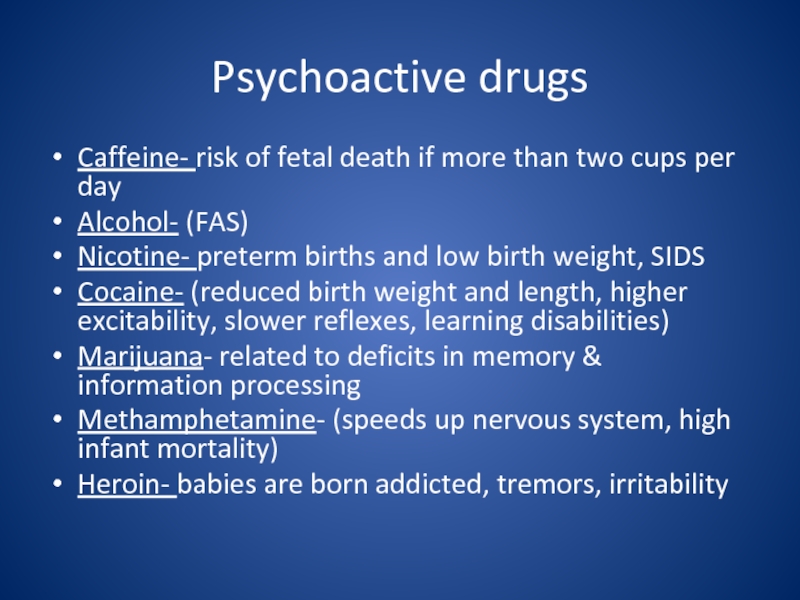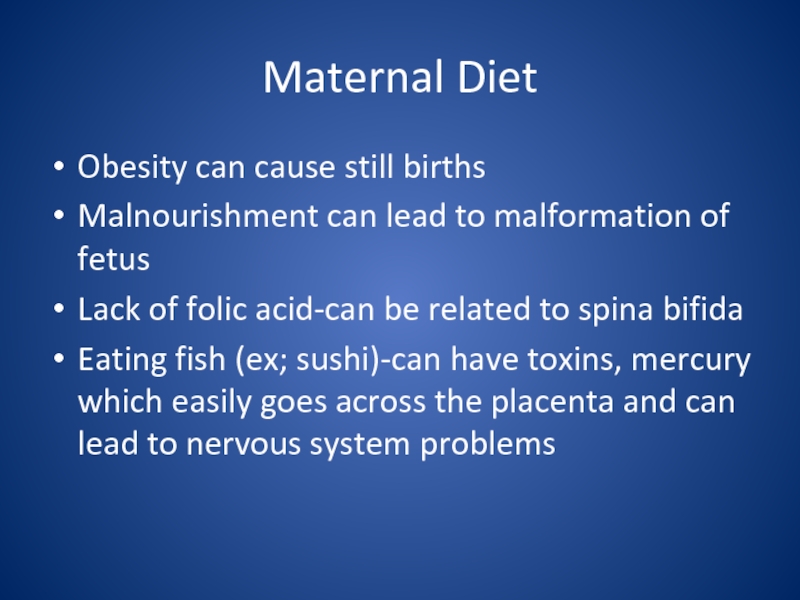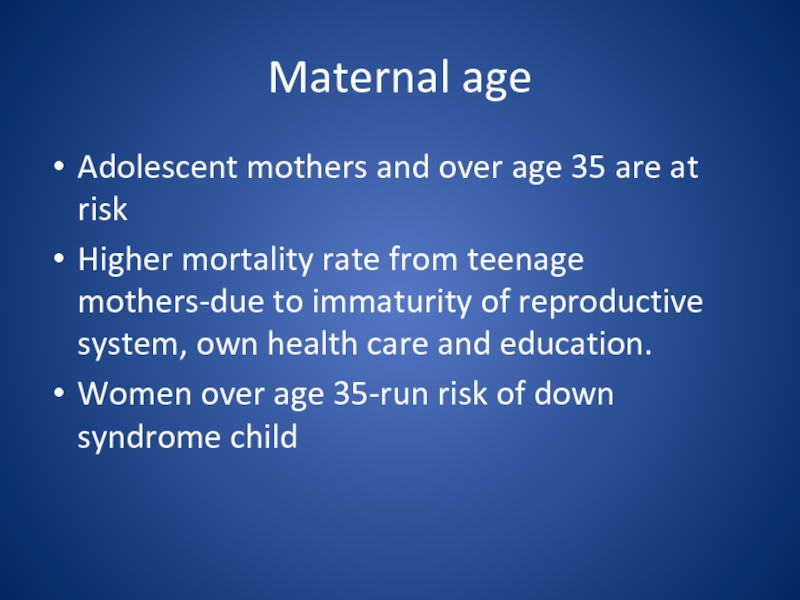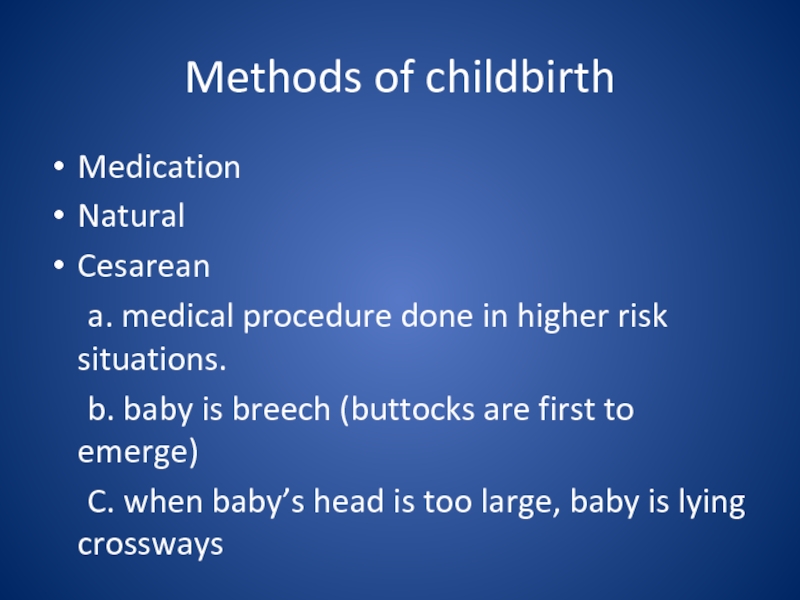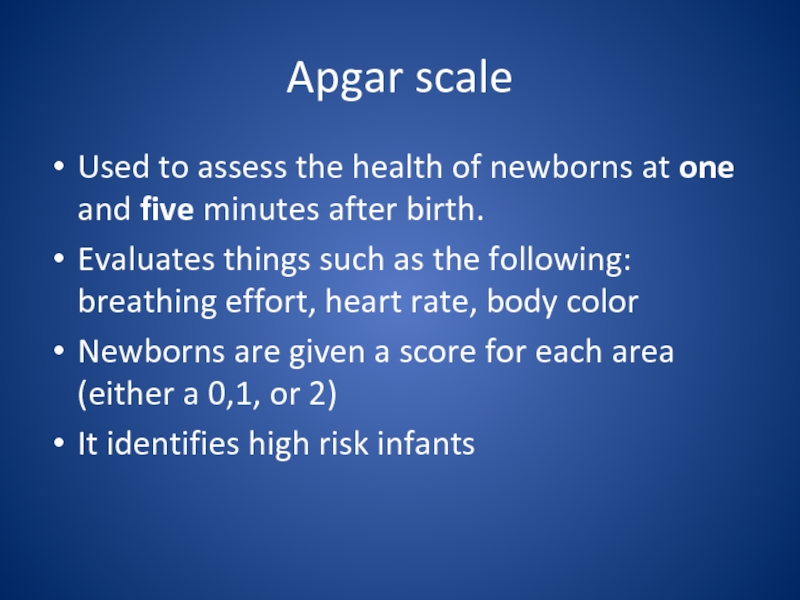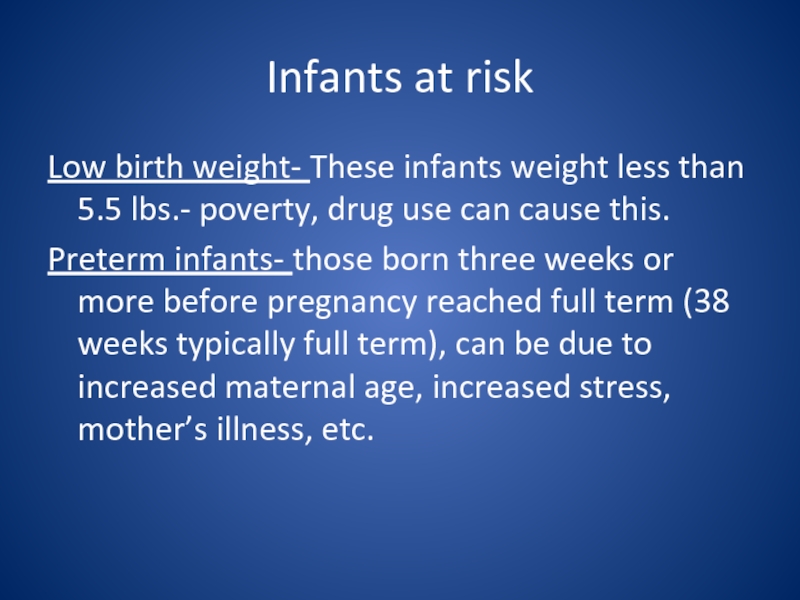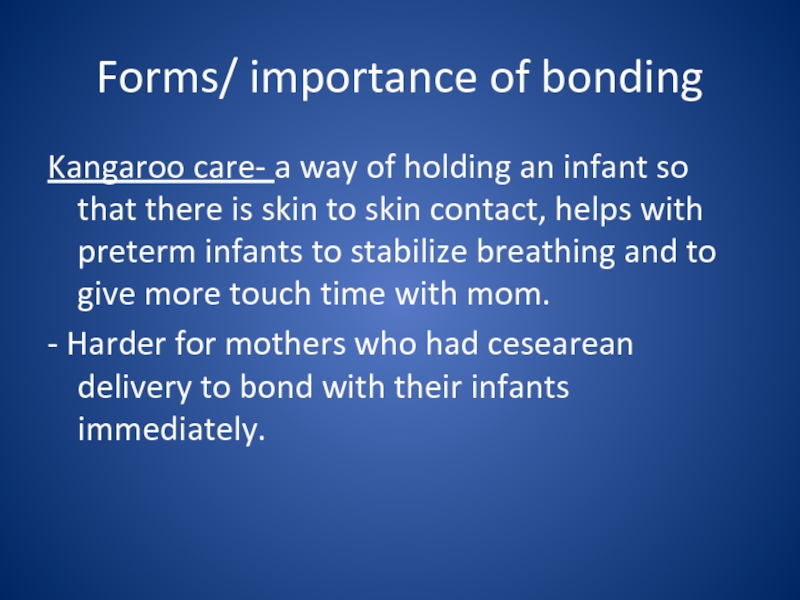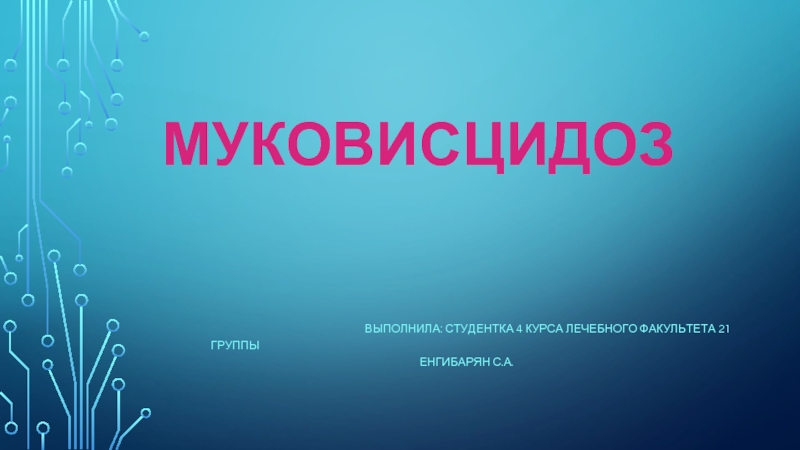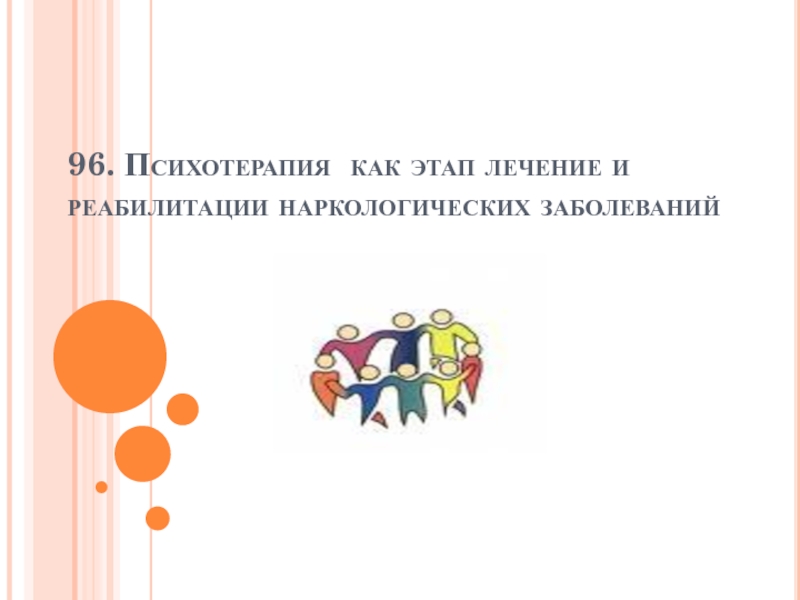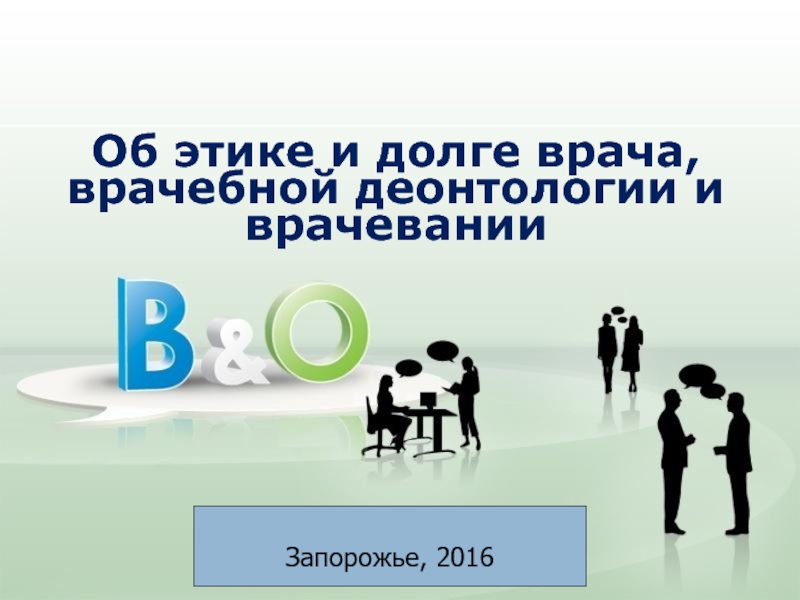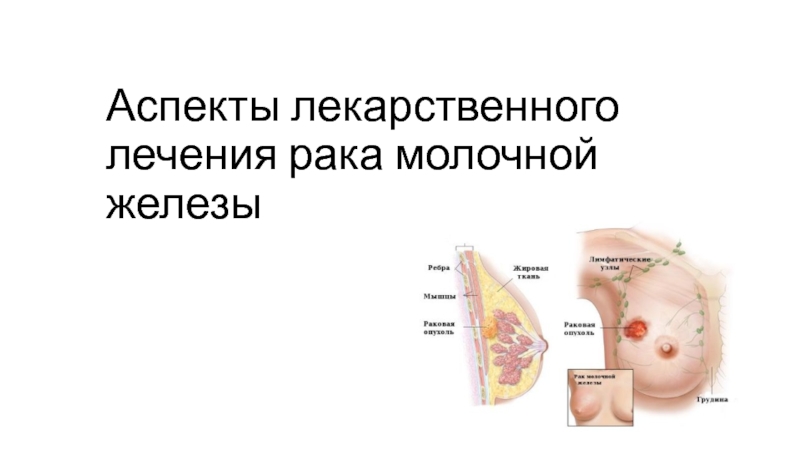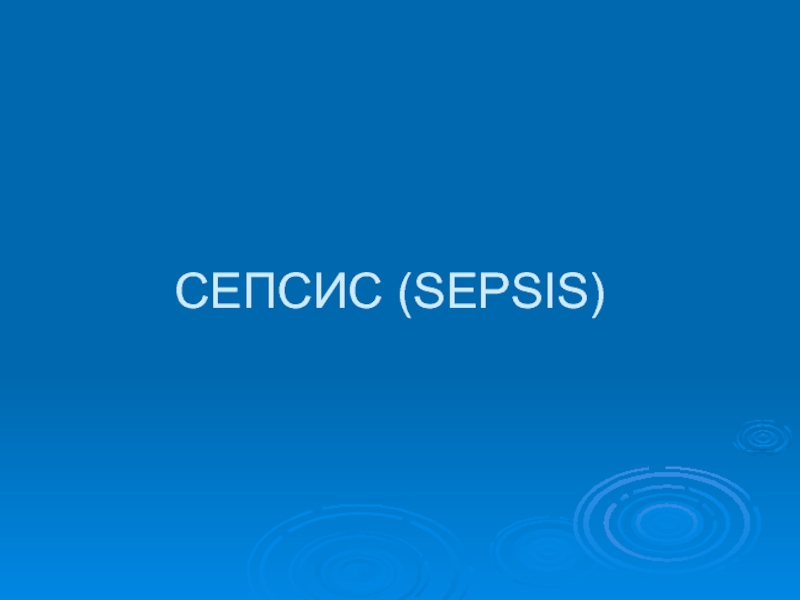- Главная
- Разное
- Дизайн
- Бизнес и предпринимательство
- Аналитика
- Образование
- Развлечения
- Красота и здоровье
- Финансы
- Государство
- Путешествия
- Спорт
- Недвижимость
- Армия
- Графика
- Культурология
- Еда и кулинария
- Лингвистика
- Английский язык
- Астрономия
- Алгебра
- Биология
- География
- Детские презентации
- Информатика
- История
- Литература
- Маркетинг
- Математика
- Медицина
- Менеджмент
- Музыка
- МХК
- Немецкий язык
- ОБЖ
- Обществознание
- Окружающий мир
- Педагогика
- Русский язык
- Технология
- Физика
- Философия
- Химия
- Шаблоны, картинки для презентаций
- Экология
- Экономика
- Юриспруденция
Biological Beginnings - Prenatal Development презентация
Содержание
- 1. Biological Beginnings - Prenatal Development
- 2. Handouts for this Chapter NY Times article- The Mysterious Tree of a Newborn’s Life
- 3. The basis of human development All cells
- 4. Dominant-Recessive genes Dominant gene- always exerts its
- 5. Prenatal development Conception- occurs when a single
- 6. Germinal period Takes place in first 2
- 7. Embryonic period Occurs from 2 to 8
- 8. Some Videos Inside Pregnancy https://www.youtube.com/results?search_query=inside+pregnancy+weeks+1+to+9&sm=1 https://www.youtube.com/watch?v=sivegxcp2Bk
- 9. More on embryonic period Life support for
- 10. The fetal period 2 months to birth
- 11. Trimesters Another way to divide prenatal development
- 12. Prenatal testing Ultrasound-noninvasive, rely on high frequency
- 13. Infertility Can be due to the male
- 14. Hazards to prenatal development Prescription/ non prescription
- 15. Teratogens Any agent that can cause a
- 16. Prescription/non prescription drugs Most harmful prescription are
- 17. Psychoactive drugs Caffeine- risk of fetal death
- 18. Maternal Diet Obesity can cause still births
- 19. Maternal age Adolescent mothers and over age
- 20. Stages of Birth Occurs in three stages:
- 21. Methods of childbirth Medication Natural Cesarean a.
- 22. Apgar scale Used to assess the health
- 23. Infants at risk Low birth weight- These
- 24. Forms/ importance of bonding Kangaroo care- a
Слайд 3The basis of human development
All cells in the body have 46
chromosomes, arranged in 23 pairs (except for the sperm and egg)
Mitosis- process in which cells reproduce, the
cell’s nucleus duplicates itself & the cell divides. Also, 2 new cells are formed with 23 pairs of chromosomes.
Meiosis- a cell from testes and a cell from the ovaries (egg and sperm-gametes) duplicate their chromosomes and then divide twice (4 cells are formed)
Fertilization- egg and sperm join to create a single cell (a zygote)
In the zygote- 23 unpaired chromosomes from egg and 23 from sperm combine to form one set of 23 paired chromosomes. So… each parent contributes half genetically to the offspring.
Google: Conception Picture Slideshow
Mitosis- process in which cells reproduce, the
cell’s nucleus duplicates itself & the cell divides. Also, 2 new cells are formed with 23 pairs of chromosomes.
Meiosis- a cell from testes and a cell from the ovaries (egg and sperm-gametes) duplicate their chromosomes and then divide twice (4 cells are formed)
Fertilization- egg and sperm join to create a single cell (a zygote)
In the zygote- 23 unpaired chromosomes from egg and 23 from sperm combine to form one set of 23 paired chromosomes. So… each parent contributes half genetically to the offspring.
Google: Conception Picture Slideshow
Слайд 4Dominant-Recessive genes
Dominant gene- always exerts its effects/ it overrides the influence
of the other gene
Recessive gene- only exerts its influence if the two genes of a pair are recessive.
Ex: the recessive gene for blue eyes will show in offspring if both parents have that recessive gene (or are carriers)
Recessive gene- only exerts its influence if the two genes of a pair are recessive.
Ex: the recessive gene for blue eyes will show in offspring if both parents have that recessive gene (or are carriers)
Слайд 5Prenatal development
Conception- occurs when a single sperm cells fuses with an
ovum (egg) in the fallopian tube. Also called fertilization.
3 main periods:
Germinal
Embryonic
Fetal
3 main periods:
Germinal
Embryonic
Fetal
Слайд 6Germinal period
Takes place in first 2 weeks after conception
Includes creation of
the zygote, cell division (mitosis), and attachment to the uterine wall
Слайд 7Embryonic period
Occurs from 2 to 8 weeks after conception
Organs start to
appear
Mass of cells is now called an embryo
Three layers of cells form:
Endoderm- inner layer which become digestive and respiratory systems
Ectoderm- outermost which become the nervous syetm, skin parts
Mesoderm- middle layer which becomes bones, muscles, circulatory system, etc.
Mass of cells is now called an embryo
Three layers of cells form:
Endoderm- inner layer which become digestive and respiratory systems
Ectoderm- outermost which become the nervous syetm, skin parts
Mesoderm- middle layer which becomes bones, muscles, circulatory system, etc.
Слайд 8Some Videos
Inside Pregnancy
https://www.youtube.com/results?search_query=inside+pregnancy+weeks+1+to+9&sm=1
https://www.youtube.com/watch?v=sivegxcp2Bk
Слайд 9More on embryonic period
Life support for embryo develops
Three components:
Amnion- contains clear
fluid in which embryo floats (shock proof)
Umbilical cord- contains two arteries and vein and connects baby to placenta
Placenta- group of tissues which pass along nutrients, oxygen, water to fetus.
Umbilical cord- contains two arteries and vein and connects baby to placenta
Placenta- group of tissues which pass along nutrients, oxygen, water to fetus.
Слайд 10The fetal period
2 months to birth
At 3 months, face, forehead, chin,
etc are distinguishable
By 5th month-mother can feel movement, can distinguish sex organs
By end of 7th month-fetus weighs approx 3 lbs and is considered viable.
During 8th and 9 month- fatty tissue develops, kidney, heart and lungs develop further.
By 5th month-mother can feel movement, can distinguish sex organs
By end of 7th month-fetus weighs approx 3 lbs and is considered viable.
During 8th and 9 month- fatty tissue develops, kidney, heart and lungs develop further.
Слайд 11Trimesters
Another way to divide prenatal development
Germinal and embryonic period occur during
the first trimester
Viability occurs at the beginning of third trimester
Developing baby is more susceptible to toxins during first trimester.
Viability occurs at the beginning of third trimester
Developing baby is more susceptible to toxins during first trimester.
Слайд 12Prenatal testing
Ultrasound-noninvasive, rely on high frequency sound waves to detect heart
beat, transformed into a visual representation of inner structures (can detect structural abnormalities)
Amniocentesis- between 15th and 18th week of pregnancy, a sample of amniotic fluid is taken and tested for disorders (chromosome & metabolic)/ can bring 1 in 200 miscarraiges
Blood screening- during 16th-18th week, can detect spina bifida and down syndrome
Amniocentesis- between 15th and 18th week of pregnancy, a sample of amniotic fluid is taken and tested for disorders (chromosome & metabolic)/ can bring 1 in 200 miscarraiges
Blood screening- during 16th-18th week, can detect spina bifida and down syndrome
Слайд 13Infertility
Can be due to the male or female
Woman may not be
ovulating, may be producing damaged eggs, fallopian tube may be blocked
Men may produce too few sperm or they may have mobility issues
Hormone treatment could be helpful or IVF
Men may produce too few sperm or they may have mobility issues
Hormone treatment could be helpful or IVF
Слайд 14Hazards to prenatal development
Prescription/ non prescription drugs
Psychoactive drugs
Incompatible blood types
Maternal diseases
Maternal
poor nutrition
Maternal age
Envirnonmental factors
Paternal factors
Maternal age
Envirnonmental factors
Paternal factors
Слайд 15Teratogens
Any agent that can cause a birth defect
Three factors related to
how damaging a teratogen can be:
Dose-the greater the dose, the more damage
Time of exposure-embryonic period is most vulnerable (when organs are being formed).
Genetic susceptibility- linked to genetic make up of mother and baby.
Dose-the greater the dose, the more damage
Time of exposure-embryonic period is most vulnerable (when organs are being formed).
Genetic susceptibility- linked to genetic make up of mother and baby.
Слайд 16Prescription/non prescription drugs
Most harmful prescription are antibiotics, antidepressants, certain synthetic hormones,
and Accutane
Most harmful non-prescription- aspirin and diet pills
Let’s watch Video on Thalidomide- http://www.nytimes.com/2013/09/23/booming/the-death-and-afterlife-of-thalidomide.html?action=click&module=Search®ion=searchResults%230&version=&url=http%3A%2F%2Fquery.nytimes.com%2Fsearch%2Fsitesearch%2F%3Faction%3Dclick%26region%3DMasthead%26pgtype%3DHomepage%26module%3DSearchSubmit%26contentCollection%3DHomepage%26t%3Dqry743%23%2Feffects+of+thalidomide&_r=1
Most harmful non-prescription- aspirin and diet pills
Let’s watch Video on Thalidomide- http://www.nytimes.com/2013/09/23/booming/the-death-and-afterlife-of-thalidomide.html?action=click&module=Search®ion=searchResults%230&version=&url=http%3A%2F%2Fquery.nytimes.com%2Fsearch%2Fsitesearch%2F%3Faction%3Dclick%26region%3DMasthead%26pgtype%3DHomepage%26module%3DSearchSubmit%26contentCollection%3DHomepage%26t%3Dqry743%23%2Feffects+of+thalidomide&_r=1
Слайд 17Psychoactive drugs
Caffeine- risk of fetal death if more than two cups
per day
Alcohol- (FAS)
Nicotine- preterm births and low birth weight, SIDS
Cocaine- (reduced birth weight and length, higher excitability, slower reflexes, learning disabilities)
Marijuana- related to deficits in memory & information processing
Methamphetamine- (speeds up nervous system, high infant mortality)
Heroin- babies are born addicted, tremors, irritability
Alcohol- (FAS)
Nicotine- preterm births and low birth weight, SIDS
Cocaine- (reduced birth weight and length, higher excitability, slower reflexes, learning disabilities)
Marijuana- related to deficits in memory & information processing
Methamphetamine- (speeds up nervous system, high infant mortality)
Heroin- babies are born addicted, tremors, irritability
Слайд 18Maternal Diet
Obesity can cause still births
Malnourishment can lead to malformation of
fetus
Lack of folic acid-can be related to spina bifida
Eating fish (ex; sushi)-can have toxins, mercury which easily goes across the placenta and can lead to nervous system problems
Lack of folic acid-can be related to spina bifida
Eating fish (ex; sushi)-can have toxins, mercury which easily goes across the placenta and can lead to nervous system problems
Слайд 19Maternal age
Adolescent mothers and over age 35 are at risk
Higher mortality
rate from teenage mothers-due to immaturity of reproductive system, own health care and education.
Women over age 35-run risk of down syndrome child
Women over age 35-run risk of down syndrome child
Слайд 20Stages of Birth
Occurs in three stages:
Uterine contractions are 15-20 minutes, cervix
begins to open. (longest stage)
baby starts to enter the birth canal, contractions are more rapid and intense,
Afterbirth- placenta, umbillical cord are detached.
Let’s watch A Walk to the Beautiful- PBS NOVA documentaryhttp://www.pbs.org/wgbh/nova/body/a-walk-to-beautiful.html
baby starts to enter the birth canal, contractions are more rapid and intense,
Afterbirth- placenta, umbillical cord are detached.
Let’s watch A Walk to the Beautiful- PBS NOVA documentaryhttp://www.pbs.org/wgbh/nova/body/a-walk-to-beautiful.html
Слайд 21Methods of childbirth
Medication
Natural
Cesarean
a. medical procedure done in higher risk situations.
b.
baby is breech (buttocks are first to emerge)
C. when baby’s head is too large, baby is lying crossways
C. when baby’s head is too large, baby is lying crossways
Слайд 22Apgar scale
Used to assess the health of newborns at one and
five minutes after birth.
Evaluates things such as the following: breathing effort, heart rate, body color
Newborns are given a score for each area (either a 0,1, or 2)
It identifies high risk infants
Evaluates things such as the following: breathing effort, heart rate, body color
Newborns are given a score for each area (either a 0,1, or 2)
It identifies high risk infants
Слайд 23Infants at risk
Low birth weight- These infants weight less than 5.5
lbs.- poverty, drug use can cause this.
Preterm infants- those born three weeks or more before pregnancy reached full term (38 weeks typically full term), can be due to increased maternal age, increased stress, mother’s illness, etc.
Preterm infants- those born three weeks or more before pregnancy reached full term (38 weeks typically full term), can be due to increased maternal age, increased stress, mother’s illness, etc.
Слайд 24Forms/ importance of bonding
Kangaroo care- a way of holding an infant
so that there is skin to skin contact, helps with preterm infants to stabilize breathing and to give more touch time with mom.
- Harder for mothers who had cesearean delivery to bond with their infants immediately.
- Harder for mothers who had cesearean delivery to bond with their infants immediately.
